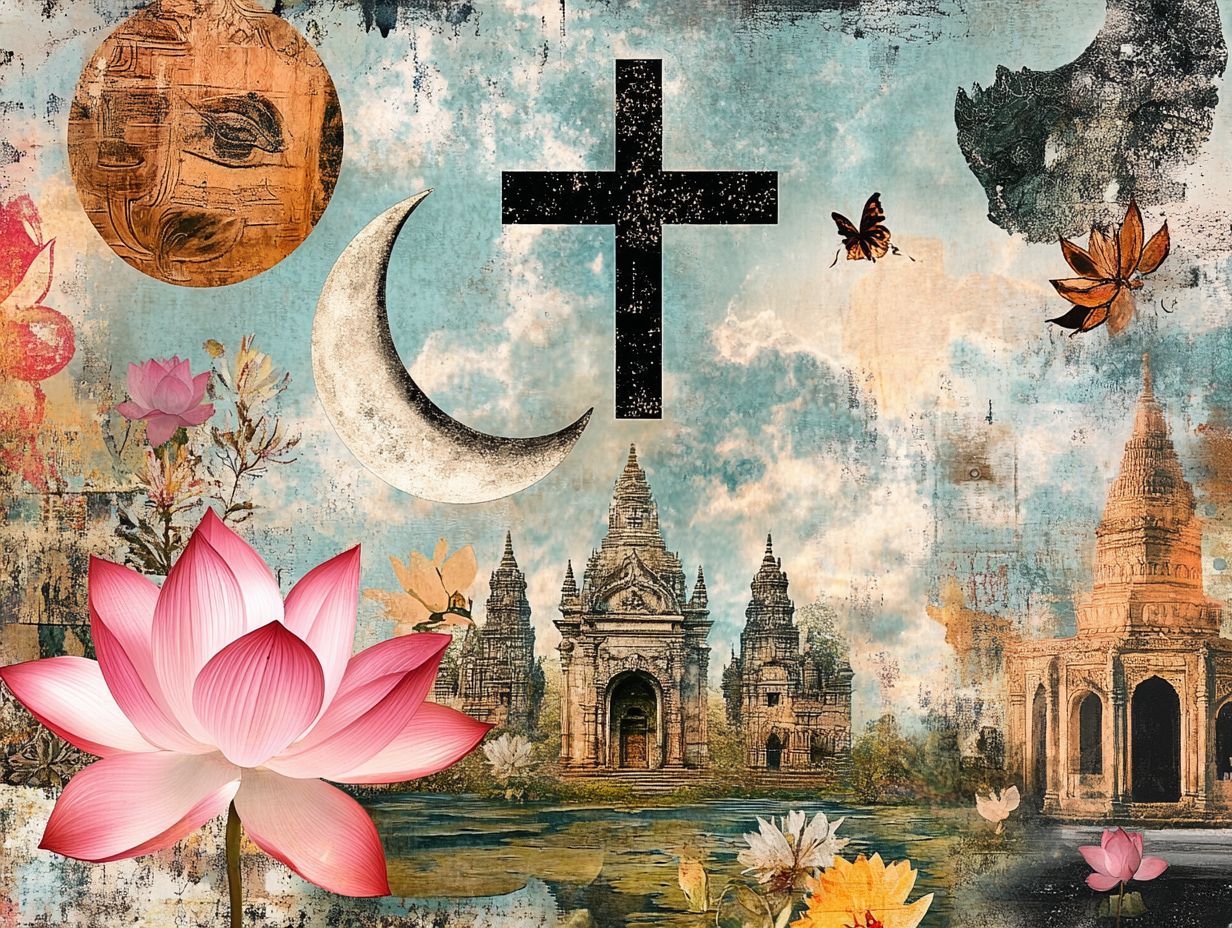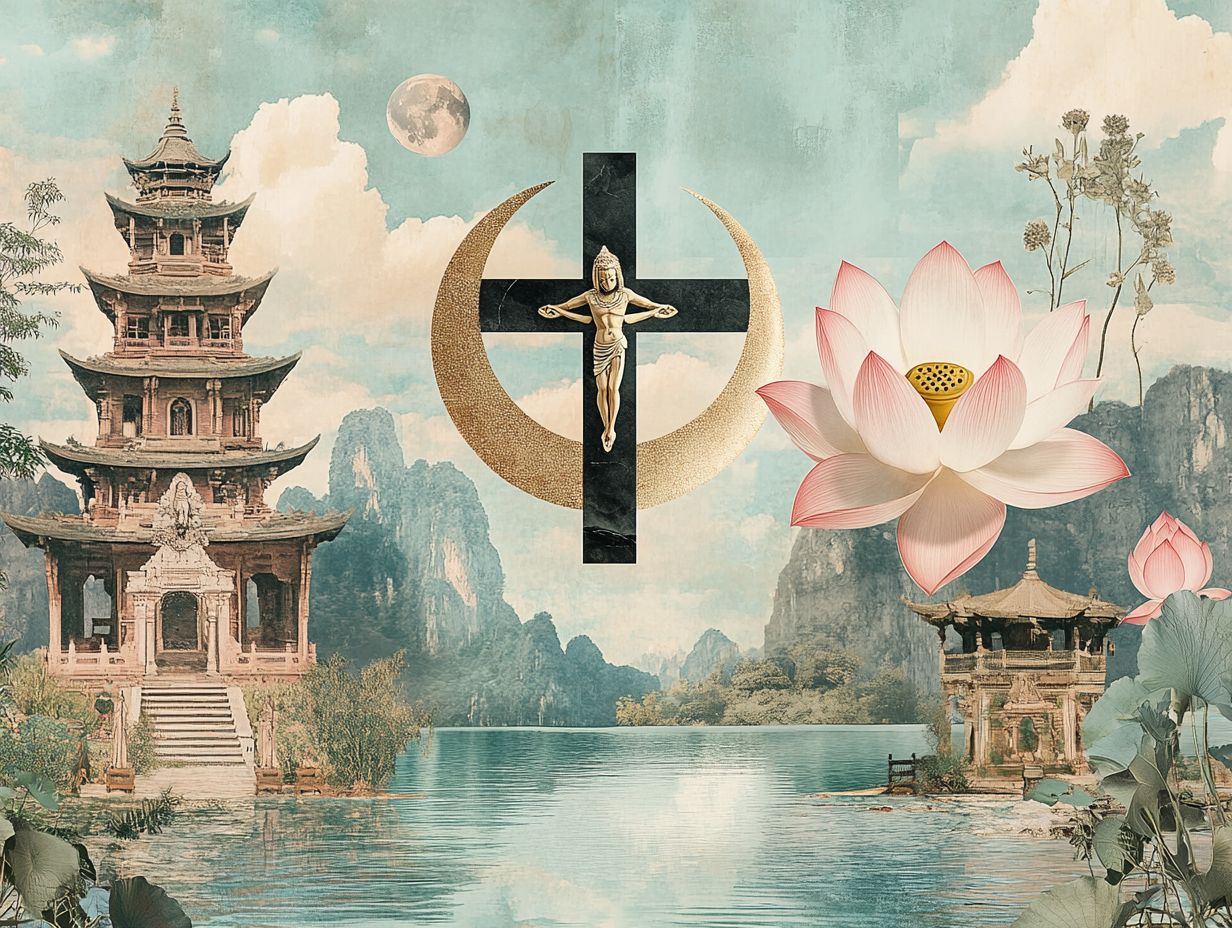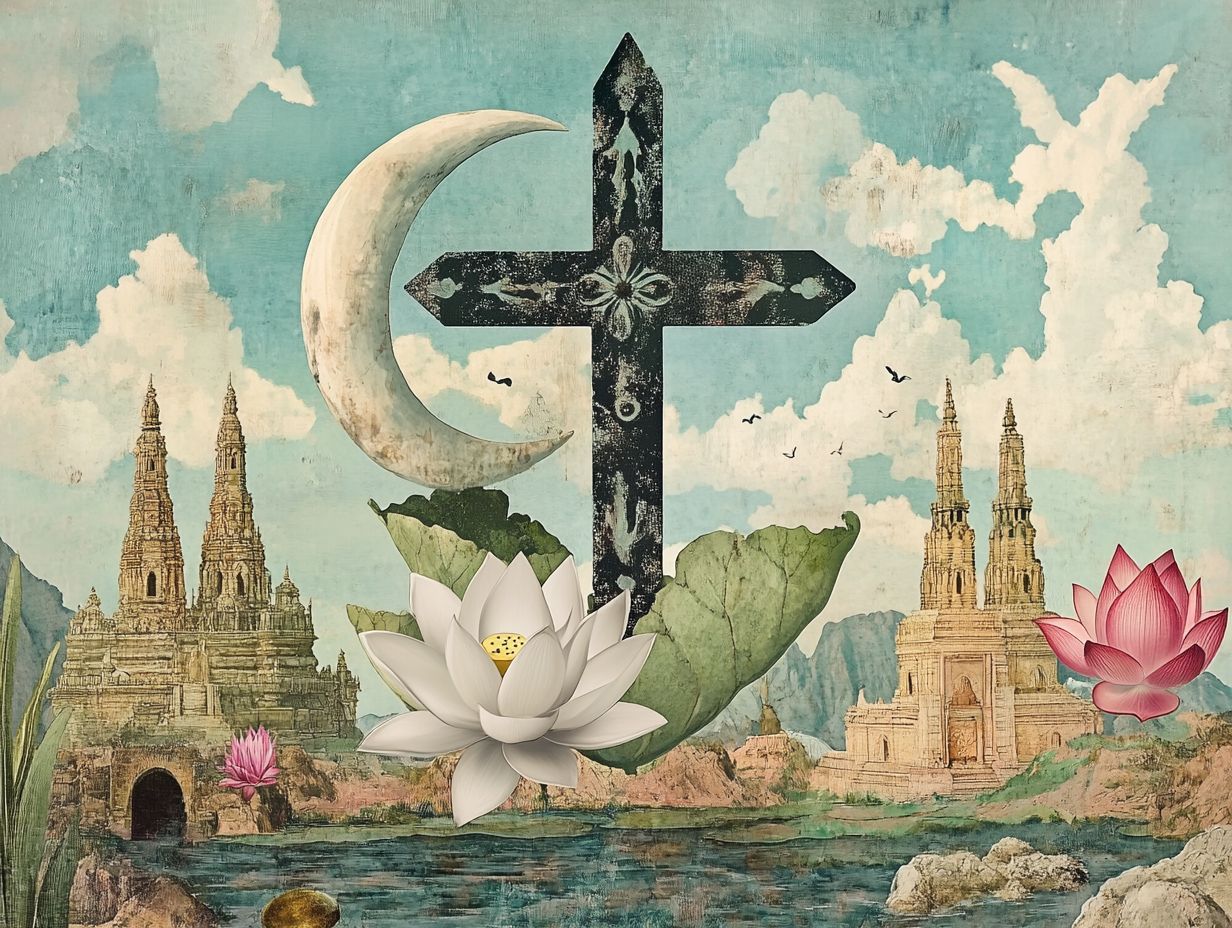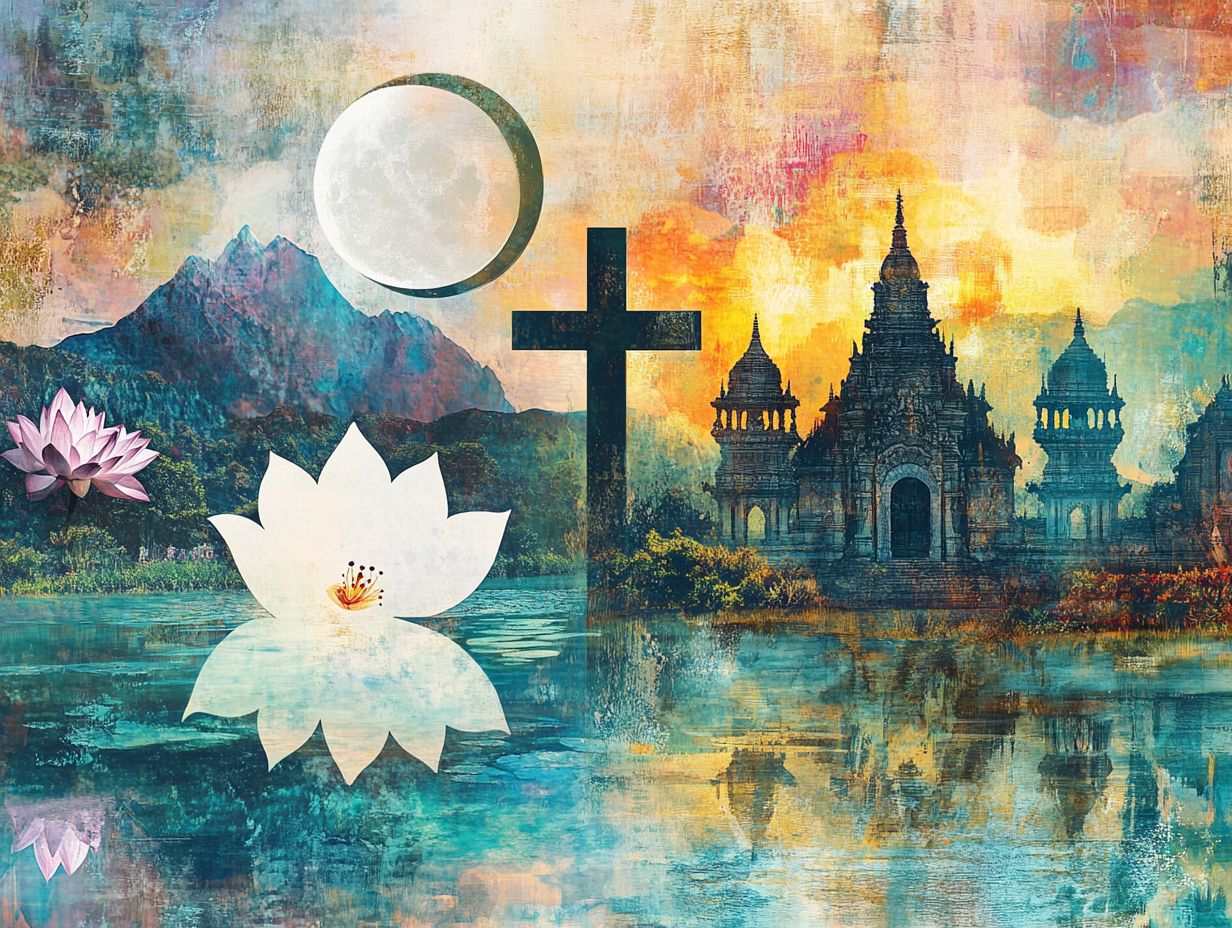What Religions Influenced Hinduism?
Hinduism stands as one of the world’s oldest religions, characterized by a wealth of traditions, beliefs, and practices, including sacred rituals performed at temples, that have seamlessly evolved over millennia.
This exploration delves into the essence of Hinduism, encompassing its core beliefs, sacred texts, historical development, and the myriad of religions, such as Jainism, Sikhism, and Zoroastrianism, that have influenced its trajectory.
It highlights the significance of the Vedas and the Bhagavad Gita, showcasing how ancient civilizations and other faiths, including Buddhism, Islam, and Christianity, have interwoven their influences into this vibrant spiritual tapestry.
Through this journey, one can uncover the captivating layers that define Hinduism, from its ancient Vedic texts to its modern spiritual practices.
What is Hinduism?

Hinduism, regarded as one of the world s oldest religions, embodies a rich tapestry of beliefs, practices, and philosophies that have intricately evolved over millennia. Its origins are deeply rooted in ancient Indian thought, drawing from the Vedic texts, Upanishads, and a myriad of scriptures that offer profound insights into its complex worldview, including concepts like Brahmanism and divine manifestations.
This religion is marked by its diversity, encompassing practices that range from the worship of multiple deities within a polytheistic framework to monotheistic expressions that highlight a singular divine essence. With a strong emphasis on fundamental concepts such as karma, dharma, and the cyclical nature of existence, Hinduism continues to exert a significant influence on spiritual practices and cultural identities around the globe.
What are the Beliefs and Practices of Hinduism?
The beliefs and practices of Hinduism are remarkably diverse, intricately woven into the fabric of the religion’s historical evolution, cultural context, and religious syncretism.
At the heart of Hindu philosophy lie pivotal concepts such as karma, which dictates the moral actions of individuals; dharma, which delineates duty and righteousness; and samsara, the perpetual cycle of birth and rebirth, ultimately leading to moksha, or liberation from this cycle.
Rituals such as puja, meditation, and the observance of festivals hold great significance in the daily lives of practitioners, nurturing a profound sense of community and shared faith.
What are the Main Hindu Texts?
Hinduism is characterized by an extensive collection of texts that form the bedrock of its religious philosophy and practices, comprising ancient scriptures, epic narratives, philosophical treatises, and the Puranas.
At the heart of this literary tradition lie the Vedic texts, which encompass hymns and rituals, as well as the Upanishads, which explore profound metaphysical questions and the quest for spiritual enlightenment.
Furthermore, the grand epics, including the Ramayana and Mahabharata within which the sacred Bhagavad Gita resides provide moral guidance, rich mythology, and deep insights into the nature of divine beings and the complexities of human existence.
1. The Vedas
The Vedas are esteemed as the oldest sacred texts of Hinduism, comprising four distinct collections that embody a rich tapestry of spiritual knowledge, rituals, and hymns. Written in ancient Sanskrit, these texts lay the groundwork for numerous spiritual practices and hold a pivotal role in Hindu rituals, representing a fundamental aspect of the religion’s historical and cultural identity, deeply influenced by the Aryan invasion theory.
Each collection namely the Rigveda, Samaveda, Yajurveda, and Atharvaveda serves a specific function, with the Rigveda primarily housing hymns intended for worship, while the Yajurveda is dedicated to the rituals themselves. The importance of these scriptures extends far beyond mere traditional recitation; they are instrumental in guiding practitioners through critical rites of passage, daily prayers, and seasonal celebrations, weaving a continuous thread that connects the past with contemporary spiritual expressions.
In the present day, the influence of the Vedas resonates across various spiritual practices, including yoga and meditation, as modern individuals strive to reclaim ancient wisdom for personal development, community connection, and a profound relationship with the divine.
2. The Upanishads
The Upanishads embody a profound philosophical and metaphysical inquiry into the principles articulated in the Vedas, delving deeply into the essence of reality, the self, and the ultimate truth. Often referred to as Vedanta, these texts offer remarkable insights into spiritual awakening, laying the groundwork for comprehending pivotal concepts such as Brahman, the ultimate reality, and Atman, the individual soul. The Upanishads also explore themes of mysticism and asceticism, crucial for spiritual development.
Within these revered writings, the teachings highlight not only the interconnectedness of all beings but also underscore the significance of self-realization as a pathway to liberation, or moksha. As seekers immerse themselves in the Upanishads, they are beckoned to ponder the nature of existence and navigate their own inner landscapes.
Such philosophical explorations possess profound implications, profoundly shaping various spiritual practices, including meditation and yoga.
Through this perspective, practitioners attain a clearer understanding of their spiritual journeys, unveiling the timeless relevance of ancient wisdom as they maneuver through the intricate challenges of contemporary life.
3. The Bhagavad Gita
The Bhagavad Gita, revered as a spiritual and philosophical masterpiece, unfolds through a profound dialogue between Prince Arjuna and Lord Krishna, skillfully addressing the moral dilemmas encountered within the realms of duty (dharma) and action (karma). This scripture offers deep insights into the essence of life, ethics, and the paths of devotion (bhakti) and knowledge, serving as a guiding light for those in pursuit of truth, ultimately leading to moksha, or liberation.
Within its eloquent verses, the text explores fundamental themes such as the significance of selfless action and the journey of personal growth through the quest for wisdom. Its teachings resonate with individuals across various epochs, encouraging them to rise above their fears and attachments to fulfill their responsibilities.
Historically, the Gita has left an indelible mark on numerous leaders and thinkers, providing clarity in times of confusion and moral dilemmas. In today’s context, its principles continue to hold relevance, inspiring individuals to navigate both personal and collective challenges, while prompting profound reflections on one’s purpose and the interconnectedness of all existence.
How Did Hinduism Evolve?

The evolution of Hinduism unfolds as a rich and intricate narrative, meticulously shaped by centuries of historical context, cultural exchanges, and interactions with diverse indigenous traditions and neighboring religions. Beginning with its early roots in the Indus Valley Civilization and extending through the Vedic period, the religion has been profoundly influenced by other faiths, such as Buddhism, Jainism, and Sikhism. The influence of Persian culture also played a role in the development of Hindu spiritual practices.
Throughout its history, Hinduism has displayed remarkable adaptability and transformation, embodying a vibrant tapestry of syncretic traditions and philosophical schools that reflect its dynamic nature.
1. The Indus Valley Civilization
The Indus Valley Civilization, recognized as one of the earliest urban cultures, offers invaluable insights into the ancient beliefs and practices that would later play a pivotal role in shaping Hinduism. Archaeological discoveries indicate that its inhabitants engaged in a variety of rituals and worshipped an array of deities, establishing foundational elements for future spiritual expressions.
Artifacts such as terracotta figurines, seals, and pottery showcase a society intricately connected to spiritual symbolism and religious practices. The discovery of mother goddess figurines alongside animal motifs points to an early form of worship that likely evolved into the diverse pantheon of Hindu deities. Moreover, the presence of sites believed to have been used for ritual bathing echoing later Hindu customs associated with sacred rivers and sacred geography suggests a continuity in values centered on purification and communal worship.
This intricate interplay between material culture and ritual practices underscores the significance of the Indus Valley Civilization in the development of Hinduism and illustrates the profound evolution of spiritual life within the subcontinent. Such insights provide essential context for understanding the roots of one of the world s oldest religions and its role in the anthropology of religion.
2. The Vedic Period
The Vedic Period signifies a transformative era in Hinduism, distinguished by the creation of sacred texts known as the Vedas and the establishment of intricate rituals that defined early Hindu practices. This epoch laid the essential groundwork for the philosophical schools and spiritual beliefs that would emerge in subsequent centuries, including the foundational elements of the caste system.
During this pivotal phase, the four Vedas Rigveda, Samaveda, Yajurveda, and Atharvaveda were meticulously composed, encapsulating hymns, prayers, and guidelines for rituals vital to both social and spiritual life. The importance of sacrificial rites, or yajnas, was paramount, serving as a means of connecting devotees with the divine, fostering communal bonds, and ensuring the maintenance of cosmic order.
Moreover, other significant texts, such as the Brahmanas, ancient Vedic texts, and Upanishads, further elaborated on these concepts, looking into metaphysical inquiries and the essence of reality. Clearly, the Vedic Period not only shaped the fundamental doctrines and moral codes of Hinduism but also set the stage for diverse interpretations of spirituality that continue to resonate with believers in contemporary times.
3. The Development of Hinduism and Its Philosophical Concepts
The development of Hinduism is characterized by a remarkable syncretism, religious pluralism, and cultural exchange, as it has adeptly assimilated ideas and practices from various sects and neighboring religions, including Buddhism, Jainism, and Sikhism. This continual evolution underscores Hinduism’s inherent adaptability and resilience, enabling it to embrace a vast array of beliefs and practices.
Over centuries, the tradition has transformed through extensive interaction with multiple cultures, resulting in a rich tapestry of philosophical thought, religious syncretism, and ritual diversity. Syncretism has been particularly instrumental in blending local customs with spiritual practices, fostering a broader acceptance of diverse paths to divinity.
The presence of sectarianism and sects has led to the emergence of distinct groups within Hinduism, each cultivating unique interpretations of scriptures and deities. This pluralistic nature of the religion not only illustrates its capacity to absorb new ideas but also showcases its ability to flourish through internal diversity, allowing for both personal and communal expressions of faith.
Which Religions Have Influenced Hinduism?
Hinduism has been profoundly shaped by a myriad of religions throughout its storied history, resulting in a rich tapestry of ideas and practices that embody intercultural dialogue and cross-religious interactions.
Notable influences include Buddhism, renowned for its focus on meditation and the pursuit of liberation; Jainism, which champions the principle of non-violence (Ahimsa); and Sikhism, which shares philosophical underpinnings and ethical teachings that resonate with Hindu thought.
1. Indus Valley Religion
The Indus Valley religion, practiced by one of the earliest civilizations, the Indus Valley Civilization, revealed a rich tapestry of spiritual practices that predate Hinduism, serving as a foundational element for its evolution. Archaeological artifacts showcase a profound reverence for deities and rituals that closely align with later Hindu beliefs.
This ancient belief system underscored the significance of ritual cleanliness and the veneration of fertility symbols, illustrating how these elements resonate with the practices that would later characterize Hinduism, including the caste system. Sacred sites, including altars and possibly early temples dedicated to deities and divine beings, indicate that worship held a central position in their society. The discovery of figurines representing various deities suggests the existence of a pantheon, mirroring the multitude of gods worshipped in contemporary Hindu tradition.
These early practices not only reflect a sophisticated understanding of spirituality but also laid the groundwork for the intricate belief systems that would develop across the subcontinent over subsequent centuries.
2. Vedic Religion

The Vedic religion, which emerged during the Vedic period following the Aryan invasion, serves as a cornerstone of Hinduism, also known as Brahmanism. It is distinguished by the recitation of hymns from the Vedas and the execution of elaborate rituals aimed at appeasing deities. This religious framework established fundamental beliefs and practices that continue to shape Hinduism today.
At the heart of this belief system lie the sacred texts known as the Vedas, which comprise four principal collections: the Rigveda, Samaveda, Yajurveda, and Atharvaveda. These texts encompass a rich tapestry of knowledge, ranging from profound philosophical discussions to meticulous guidelines for sacrificial rituals.
Rituals held immense significance in the Vedic religion, with each ceremony meticulously crafted to invoke specific deities, thereby fostering harmony within both the natural and social orders.
The spiritual beliefs inherent in this tradition emphasize a profound reverence for nature and cosmology and the cosmos, reflecting an intricate understanding of the interconnectedness of all life. Consequently, the traditions established during this period have significantly influenced not only religious practices but also the philosophical inquiries that continue to shape contemporary Hindu thought in spiritual philosophy and metaphysics.
3. Buddhism
Buddhism, which originated in India, has significantly influenced Hinduism, particularly in the realms of meditation practices and the concepts of karma and enlightenment and spiritual awakening. The shared philosophical foundations have given rise to both conflict and coexistence between these two prominent religions throughout history.
The interaction between these traditions presents a rich tapestry of syncretic traditions of beliefs, where ideas such as dharma the ethical path and the cyclical nature of life are intricately intertwined. Practitioners of both faiths frequently adopt similar meditative techniques, placing a strong emphasis on mindfulness and self-realization as avenues toward spiritual liberation.
Despite their distinct doctrines, the shared focus on compassion, non-violence, and the pursuit of truth reveals a notable overlap that fosters mutual exchange and respect. This interconnectedness has not only shaped individual practices but has also contributed to a broader cultural dialogue that has endured across centuries.
4. Jainism and Ascetic Practices
Jainism has profoundly influenced Hindu thought, particularly through its doctrine of Ahimsa, or non-violence. This principle has been embraced and woven into the fabric of Hindu practices and ethics, fostering a dynamic dialogue between the two religions throughout the ages.
The emphasis on ethical living and spiritual purity in Jainism has permeated Hindu rituals and philosophies, resulting in a mutual enrichment of beliefs. Both traditions champion the values of truthfulness, compassion, and self-discipline, highlighting their shared commitment to the pursuit of spiritual enlightenment and liberation.
Furthermore, the ascetic practices inherent in Jainism have inspired Hindu devotionals, encouraging practitioners to adopt lifestyles that prioritize detachment and meditation. This intermingling of ideals not only underscores their common values but also illustrates how Jain concepts continue to resonate within Hinduism’s expansive tapestry of beliefs, ultimately enriching the spiritual landscape for followers of both faiths.
5. Sikhism
Sikhism, which emerged from the Indian subcontinent, possesses significant historical and philosophical ties to Hinduism, encompassing shared beliefs in karma, dharma, and the ultimate quest for spiritual truth. This interconnectedness has cultivated a rich tradition of interfaith dialogue and mutual respect.
Both religions underscore the importance of ethical living and community service, fostering a culture of inclusivity and acceptance in their coexistence. Sikh teachings advocate for equality and altruism, principles that resonate profoundly with the Hindu ideals of compassion and righteousness.
As a result, many individuals within the Sikh community participate in Hindu festivals, showcasing the fluidity of cultural practices. This blending of traditions not only enriches the spiritual landscape of the region but also highlights the shared values uniting these faiths, promoting a harmonious coexistence that transcends doctrinal differences.
6. Christianity
Christianity, recognized as one of the major world religions, has notably influenced Hinduism through interfaith dialogue and the exchange of moral values. The interactions between these two faiths have fostered a deeper understanding and respect for their differing beliefs and practices.
This influence is particularly evident in the realms of ethics and charity, where shared teachings about compassion and service resonate within both traditions. The dialogue initiated by scholars and religious leaders creates a collaborative atmosphere, inviting followers to explore common human values such as peace, love, and mutual respect through interfaith dialogue.
Both Christianity and Hinduism place a high premium on moral integrity, which can enrich the spiritual lives of their practitioners. The cross-pollination of ideas between these religions allows for a more nuanced appreciation of devotion and spirituality, illuminating the shared aspirations of their respective communities in the quest for a more harmonious existence.
7. Islam
Islam, as another prominent world religion influenced by Zoroastrianism and Persian culture, has engaged with Hinduism throughout history, fostering cultural exchanges and influences that have significantly shaped both faiths. Central to their coexistence are the principles of communal harmony and mutual respect, which have emerged as vital themes.
This dynamic interplay has woven a rich tapestry of traditions, philosophies, and practices, enabling adherents of both religions to discover common ground and shared values. Historical events, such as the arrival of Sufi saints in India, serve as compelling examples of how teachings centered on love and devotion transcended religious boundaries, establishing a fertile ground for dialogue and understanding.
Art, music, and literature have played crucial roles as mediums through which these two communities have articulated their experiences, nurturing a sense of unity amid diversity. Additionally, the influence of ancient Vedic texts, Upanishads, and philosophical concepts has been profound in shaping cultural narratives.
Such interactions have not only enhanced the cultural landscape but also fostered a deeper appreciation for each other’s faiths.
8. Zoroastrianism

Zoroastrianism has profoundly influenced Hinduism through the exchange of religious philosophies and metaphysical beliefs, particularly concerning the concepts of good and evil and the nature of divinity. This exchange is a testament to religious syncretism and the blending of diverse philosophical concepts.
This interaction highlights the interconnectedness of religious traditions across time and geography.
The dualistic themes present in both faiths underscore a shared understanding of moral dichotomies, urging adherents to pursue righteousness while actively opposing malevolent forces. These dualities are also reflected in other traditions, such as Sufism within Islam and Gnosticism in esoteric Christianity.
Such parallels are evident in the Hindu concepts of Dharma and Karma, which resonate with Zoroastrian ideals of Asha, representing truth and order, alongside the enduring struggle against Angra Mainyu, the spirit of chaos.
Additionally, both religious traditions delve into the significance of rituals and the sanctity of fire, which symbolizes purity and the divine presence. Such rituals are also central to the practices in Brahmanism and the Indus Valley Civilization.
As these philosophies intertwined, they not only created a rich tapestry of beliefs but also fostered a deeper appreciation for the ethical dimensions of existence and the transcendental aspects of life.
Frequently Asked Questions
What religions influenced Hinduism?
The main religions that influenced Hinduism were Vedic religion, Sikhism, Islam, Christianity, Buddhism, and Jainism.
How did Vedic religion and ancient texts influence Hinduism?
Vedic religion, which was dominant in ancient India, played a significant role in shaping the beliefs and practices of Hinduism. Many of the Vedic gods and rituals were adopted by Hinduism. This period also saw the integration of Brahmanism and contributions from the Aryan invasion.
What impact did Buddhism and Jainism have on Hinduism?
Buddhism, which originated in India and spread throughout Asia, had a major influence on Hinduism. Many Buddhist teachings, such as the concept of karma and meditation, were incorporated into Hinduism. Similarly, Jainism’s emphasis on non-violence and the bhakti movement significantly shaped Hindu moral and ethical dimensions.
In what ways did Jainism and Sikhism influence Hinduism?
Jainism, another religion that emerged in ancient India, had a significant impact on Hinduism. Jainism’s emphasis on non-violence and the concept of ahimsa (non-harming) influenced the development of Hinduism’s ethical principles. Additionally, Sikhism contributed to the evolution of Hindu practices and its spiritual philosophy.
How did other religions and traditions influence Hinduism?
Aside from Vedic religion, Buddhism, and Jainism, Hinduism also drew inspiration from other religions such as Zoroastrianism, Greek philosophy, and Sikhism. These religions contributed to the diversity and evolution of Hinduism, fostering a culture of religious tolerance and multiculturalism. The influence of Persian culture and Indo-European religions also played significant roles in shaping Hinduism.
How did the influence of these religions shape Hinduism as it is today?
The influence of various religions on Hinduism resulted in the formation of a complex belief system with diverse practices and rituals. This has also led to a rich tradition of temple architecture, festivals, and pilgrimage.
It also allowed for the incorporation of new ideas and beliefs, making Hinduism a dynamic and adaptable religion.
